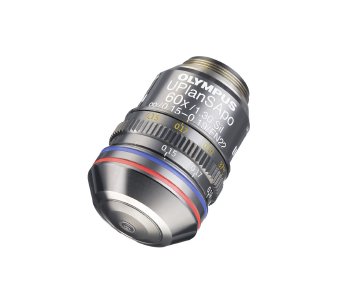Jun 9 2011
Olympus has introduced two new silicon oil-immersion objectives, the UPLSAPO30xS and UPLSAPO60xS. The new lenses are ideal for live cell experiments, particularly those investigating thick samples or requiring long-term imaging. Users can generate bright images at higher resolution, as silicon oil significantly improves optical performance in comparison to conventional oil- or water-based approaches.
This maximises the effectiveness of brightfield, differential interference contrast (DIC), fluorescence, confocal laser scanning and multiphoton studies. In addition, long-term time-lapse experiments can now be more reliably carried out without fear of evaporation or changes in refractive index, as silicon oil has high stability and low volatility. With increased brightness, resolution and reproducibility, the new unique Olympus silicon oil-immersion objectives are ideal for long-term or deep-penetration imaging.

Silicon oil allows users to capture bright, high resolution images of living samples, even deep into cells and tissues. This can be achieved because the refractive index of silicon oil (n = 1.40) is almost identical to that of living biological samples, at n =1.38, so silicon oil-immersion objectives minimise refractive index mismatch and spherical aberration. The properties of silicon oil also make it ideal for long-term, stable time-lapse studies. Unlike water, silicon oil is stable, viscous and of low volatility, meaning it does not dry out over time as water can. While glycerol has traditionally been used to circumvent some of the problems associated with water-immersion lenses, the properties of glycerol oil can change during the cause of an experiment as it tends to absorb moisture from the surrounding air. Silicon oil does not suffer from this issue, making it the medium of choice for performing reliable, reproducible long-term imaging.
With its 30x magnification and high NA of 1.05 the UPLSAPO30xS delivers highly resolved images of an extensive sample area. The Olympus UPSLAPO60xS provides increased magnification (60x) and NA (1.30), allowing researchers to produce highly detailed live sample images using fluorescence, confocal laser scanning and multiphoton excitation techniques. This objective is also ideal for high resolution 3D imaging applications by offering improved spherical aberration correction and a shorter working distance of 0.3 mm.
Each of the new objectives features a correction collar, making it easy to reduce spherical aberration even further via simple collar adjustments, optimising resolution, contrast and fluorescence performance. By integrating the new UPLSAPO30xS and UPLSAPO60xS lenses into their microscopes, researchers can build a complete system, optimised for clarity, resolution and reproducibility when performing deep-tissue and long-term imaging.